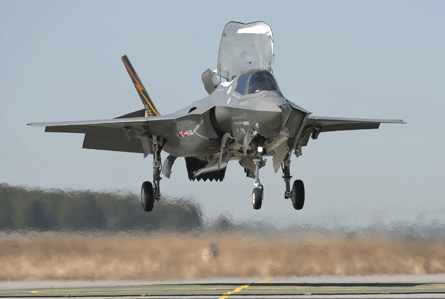Lockheed Martin and Pratt & Whitney have revealed the extent of design changes required to release the short take-off and vertical landing F-35B from a newly imposed "probationary" status within two years.
The Joint Strike Fighter programme is now cleared to spend another $4.6 billion partly to correct structural and propulsion design flaws in the F-35B. But patience is swiftly cooling with the specialised variant ordered by the US Marine Corps.
While the US Air Force's conventional take-off and landing F-35A and the US Navy's F-35C carrier variant are "proceeding satisfactorily" in tests, Secretary of Defense Robert Gates says the Marine Corps' prized stealth fighter is "experiencing significant testing problems".
The F-35B's troubles appear to have been recognised by the programme's international partners. UK Prime Minister David Cameron shelved plans in October to buy the type in favour of the carrier-based F-35C, leaving only Italy as a potential buyer among the nine major partners.
 |
|---|
© Lockheed Martin |
Three months after Cameron's decision, Gates announced the two-year probation order, seemingly giving the USMC and Lockheed one last chance to fix the F-35B's problems.
Lockheed first has redesigned one of six major bulkheads that cracked on the BH-1 ground-test aircraft less than 10% through a 16,000h durability test in November. The company now adds that "other locations of similar design" on the F-35B are also being evaluated.
In a positive sign, Lockheed has determined that aluminium material did not cause the cracking problem. Cracks formed on the aircraft's Alcoa-supplied No 496 bulkhead, where the fuselage attaches to the main landing gear. This created a "large stress concentration", Lockheed says. The company's decision to convert the bulkhead structure from titanium to a lighter-weight, aluminium alloy in 2004 was not a factor, it says.
P&W, meanwhile, is making three changes to the propulsion system engaged only during STOVL operations. The driveshaft, lift-fan clutch and actuator for the roll-post nozzles as currently designed meet Lockheed's original specifications, says Bennett Croswell, P&W's vice-president for F135 and F119 programmes.
But experience in flight-testing has revealed that each of the three components encounter surprising conditions.
In STOVL mode, the driveshaft contracts and expands more than expected, and the actuators for the roll-post nozzles are blasted by more heat than anticipated. Plates in the clutch fan, meanwhile, touch unexpectedly during normal flying mode, which "very infrequently" creates more heat than the clutch is designed to tolerate, Croswell says.
Gates says the F-35B's possible redesign could "add yet more weight and more cost to an aircraft that has little capacity to absorb more of either".
Croswell, however, believes the propulsion redesign can avoid penalising the aircraft's price tag or performance. "From a cost and a weight standpoint, [the impact] will be minimal," he says. In the case of the driveshaft, P&W's goal is to reduce the cost of the strengthened, Rolls-Royce-supplied component as a result of the redesign, he adds.
The STOVL variant was always expected to pose the hardest design challenges of the three F-35 models. It is the first fighter to blend stealth features, supersonic speed and advanced avionics with the unique ability to take off within roughly 250m (820ft) and land vertically.
Such capabilities make the F-35B essential for the USMC, which lacks aircraft carriers with catapult launchers and relies on fighters to support relatively lightly armed ground units.
But the variant's unique performance requirements drove a major redesign in 2004 that became the first in a series of delays and cost overruns reported by all three F-35 variants.
In flight tests, the F-35A and F-35C both exceeded a greatly reduced set of flight-test goals in 2010, but the F-35B notably struggled. Although the BF-1 flight-test aircraft achieved its first vertical landing in March 2010, reliability problems slowed the pace of flight tests. In late September, Lockheed grounded the F-35B to fix a critical issue with a hinge opening the auxiliary inlet door for the lift-fan.
It would be nearly four months before the BF-2 flight-test aircraft completed another vertical landing on 6 January.
If such lapses continue, the F-35B programme could be cancelled. Gates announced on 6 January that tests for the F-35A and F-35C variants would be decoupled from the STOVL version. The US Navy, meanwhile, will buy 41 more Boeing F/A-18E/F Super Hornets over the next three years and slash planned orders for the F-35B from 61 to 20 over the same period.
Lockheed has already received $37 billion to develop and test three variants over nine years, plus contracts worth roughly $10 billion more to deliver 62 jets in the first four lots of low-rate initial production (LRIP). So far, only 10 of 13 flight-test aircraft have been delivered and none of the LRIP fighters.
Source: Flight International



















